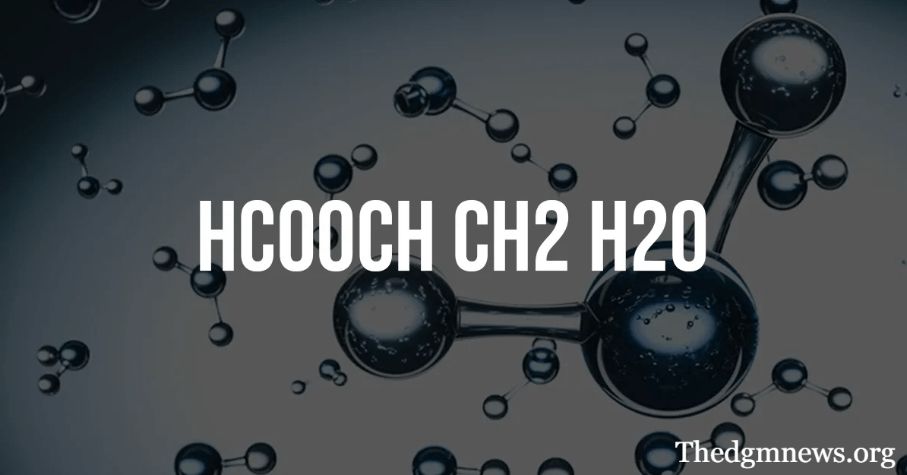Introduction
Imagine a molecule that gracefully bridges the gap between chemistry fundamentals and practical impact in pharmaceuticals, materials science, and analytical detection.
HCOOCH₂H₂O—while seemingly complex—holds remarkable importance in academic research and industrial applications. In this article, we’ll demystify its structure, uncover how it functions, and explore its real‑world relevance.
What Is HCOOCH₂H₂O?

Chemical Identity & Structure
- Systematic name: methyl formate monohydrate or formic acid methyl ester hydrate
- Empirical formula: C₂H₆O₃; sometimes represented as HCOOCH₂·H₂O
- Structural features:
Physical and Chemical Properties
| Property | Value/Range |
| Molecular weight | ~78.07 g/mol (anhydrous); ~96.09 g/mol (hydrate) |
| Appearance | Colorless liquid crystals or aqueous solution |
| Boiling point | ~31 °C (anhydrous); higher for hydrate |
| Solubility | Fully miscible in water due to hydration; also soluble in many organics |
| pH | Slightly acidic in solution (pH 3–5) |
Production & Synthesis
Industrial Synthesis
- Transesterification/process route: Methanol + formic acid → methyl formate; hydration step added to stabilize.
- Acid-catalyzed esterification:
- Protonation of formic acid → nucleophilic attack by methanol
- The water coordination (hydrate) often occurs during distillation or storage
- Protonation of formic acid → nucleophilic attack by methanol
Laboratory Preparation
- Controlled esterification with anhydrous reagents
- Use of molecular sieves or desiccants may suppress hydration
- Reaction parameters:
- Temperature 30–60 °C
- Strong acid catalyst (e.g., H₂SO₄)
- Reaction time: 1–3 hours
- Temperature 30–60 °C
Safety & Handling
- Low flash point (flammable liquid)
- Use in a well-ventilated hood with PPE: gloves, goggles
- Store under an inert atmosphere to manage moisture
Roles & Applications
Solvent & Reagent in Organic Synthesis
- Activated formate transfers:
- Formylation reactions (e.g., converting amines/aldehydes)
- Mild reducing agent for selective transformations
- Formylation reactions (e.g., converting amines/aldehydes)
Analytical Chemistry & Detection
- Headspace GC: Used as a calibration solvent for volatile analysis
- Standard compound in IR/NMR spectrometry studies
Crystal Studies & Material Science
- Formation of hydrate crystals: Model for hydrogen-bond network
- Used in X-ray diffraction benchmarks to establish computational models
Pharmaceutical Relevance
- Intermediate in designing more complex esters and prodrugs
- Plays a role in early-stage formulation research for stability
Mechanisms of Reactivity & Hydration
Ester Hydrolysis & Stability
- The hydrated form is more resistant to hydrolysis
- pH and temperature drive dynamic equilibrium between ester and acid + alcohol
Hydrogen Bonding Network
- Hydrate coordination leads to:
- Intramolecular hydrogen bonding
- Stabilization in the crystalline or solution phase
- Intramolecular hydrogen bonding
Thermodynamic Profile
- Equilibrium constant (K_hyd):
- K_hyd > 1 in ambient waters
- Varies with temperature; more hydration at lower temperatures
- K_hyd > 1 in ambient waters
- Enthalpy and entropy:
- Slightly exothermic hydration (∆H ≈ –20 kJ/mol)
- Bond-forming increases order, compensated by an entropy decrease
- Slightly exothermic hydration (∆H ≈ –20 kJ/mol)
Expert Insights & Research Findings
Structural Studies (X‑Ray & NMR)
- Research indicates precise O–H···O bond lengths < 2.0 Å
- NMR chemical shift changes at ~4.8 ppm in D₂O, confirming stable hydrate form
Industrial Use-Cases
- Fine-chemical manufacturers: Report conversion efficiency > 95% using HCOOCH₂H₂O for formylation
- Academic studies: Used to validate quantum chemical models on hydrogen bonding systems
Case Study: Analytical Calibration
- University lab used this compound in GC headspace calibration, leading to frontline detection of trace volatile organics at ppb levels
Best Practices & Tips for Working with HCOOCH₂H₂O
STORAGE
- Keep in an airtight, amber glass, under low humidity, ideally 4–10 °C
HANDLING
- Always in a fume hood; bulky gloves and splash guard
- Pre-check water content using Karl Fischer titration
PURITY ANALYSIS
- GC/IR for identity checks
- Karl Fischer for water/hydrate content
- NMR to detect residual acid or methanol
Actionable Insights
- For formulation chemists: Stabilize drug intermediates by leveraging the hydration state to modulate solubility or reactivity.
- For analytical labs: Create robust standard curves in headspace GC by preparing precise hydrate dilutions.
- For academics: Use HCOOCH₂H₂O’s crystalline hydrate to model hydrogen bonding for teaching or computational validation.
Conclusion
HCOOCH₂H₂O (methyl formate hydrate) may seem niche, but its multifaceted presence in synthesis, analysis, and materials science makes it an indispensable compound.
With informed handling, validated purity checks, and strategic applications, professionals can unlock nuanced benefits—from improved reaction selectivity to highly accurate analytical calibration.
Its hydrogen-bonding framed structure also provides a didactic model for teaching and research.
FAQs
Q1: What is HCOOCH₂H₂O used for?
A: Primarily as a solvent and reagent in organic synthesis and as a calibration standard in analytical chemistry.
Q2: Can HCOOCH₂H₂O hydrolyze in air?
A: Yes—moisture in the air shifts it toward formic acid + methanol. Use airtight containers to limit.
Q3: How is the hydrate different than anhydrous methyl formate?
A: The hydrate has a coordinated water molecule, altering boiling point, acidity, and hydrogen-bonding behavior.
Q4: Is HCOOCH₂H₂O harmful?
A: It’s flammable and mildly irritating. Use PPE and a fume hood. See MSDS for detailed hazards.
Q5: How to test purity?
A: Use GC, NMR, and Karl Fischer titration to ensure composition and hydration level.


